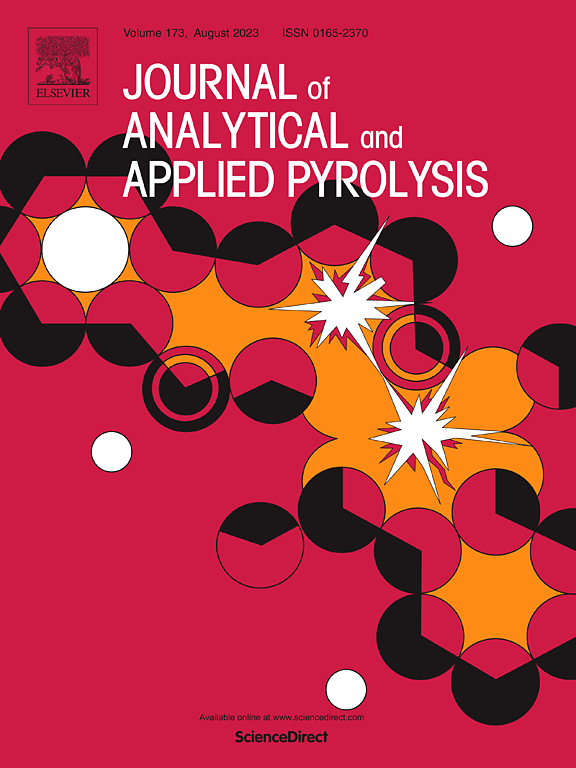Tmax-S: A new proxy for the role of sulfur on sedimentary organic matter preservation and thermal maturation
IF 5.8
2区 化学
Q1 CHEMISTRY, ANALYTICAL
引用次数: 0
Abstract
In this study, we introduce a new geochemical proxy based on the Tmax-S parameter presented in Cohen-Sadon et. al., (2022). We discuss Tmax-S applicability using various kerogen types and through thermal maturation experiments. Tmax-S, in analogy to the conventional Tmax (Tmax-HC), is the temperature at maximum organic-sulfur (S) elution during a Rock-Eval® 7S pyrolysis. Tmax-S demonstrates a strong dependency to the sulfide/thiophene bonds ratios. Low (< 400 °C) or high (> 415 °C) Tmax-S values indicate abundancy of thermally labile sulfide cross-linkage or refractory thiophene bonds, respectively. In sedimentary rocks, organic-S bonds distribution depends on how S is incorporated into sedimentary organic molecules (sulfurization) and its alteration during thermal maturation. Various thermally immature samples show a correlation (R2 = 0.70) between Tmax-S to the ratio of reactive Fe to H2S, indicating that reactive Fe availability controlled the sulfurization pathway through inter or intra-molecular S addition. With the organic S/C ratio, Tmax-S in immature rocks distinguish between sulfurization pathways and the overall sulfurization intensity. Therefore, Tmax-S can assess sulfurization contribution to organic matter preservation and improves the reconstruction of paleo-environmental conditions such as reactive Fe availability. During thermal maturation, Tmax-S provides a proxy for organic-S structural variations. Compared to Tmax-HC, Tmax-S has a better resolution, by a factor of six, at the early maturation stage. With the conventional Rock-Eval® proxies, Tmax-S demonstrates the dynamic of S compounds and HC generation along with the organic-S structural rearrangement in the remaining kerogen. Thus, Tmax-S is a rapid, robust and simple proxy for diagenetic and thermal maturation processes of sedimentary organic matter.
Tmax-S:硫对沉积有机质保存和热成熟作用的新指标
本文基于Cohen-Sadon et al.(2022)提出的Tmax-S参数,引入了一种新的地球化学代理。通过热成熟实验,讨论了Tmax-S在不同干酪根类型下的适用性。与传统的Tmax (Tmax- hc)类似,Tmax-S是Rock-Eval®7S热解过程中有机硫(S)最大洗脱温度。Tmax-S表现出对硫化物/噻吩键比的强烈依赖性。低(& lt;400 °C)或更高(>;415 °C) Tmax-S值分别表示热不稳定的硫化物交联或难熔的噻吩键的丰度。在沉积岩中,有机质-S键的分布取决于S如何与沉积有机分子结合(硫化)及其在热成熟过程中的蚀变。各种热未成熟样品的Tmax-S与活性铁与H2S的比值呈相关(R2 = 0.70),表明活性铁的有效性通过分子间或分子内S的加入控制了硫化途径。未成熟岩石的Tmax-S通过有机硫碳比来区分硫化途径和整体硫化强度。因此,Tmax-S可以评估硫酸化对有机质保存的贡献,并改善古环境条件(如活性铁有效性)的重建。在热成熟过程中,Tmax-S是有机质- s结构变化的代表。与Tmax-HC相比,Tmax-S在早熟阶段具有更好的分辨率,达到六倍。与传统的Rock-Eval®替代指标相比,Tmax-S显示了S化合物和HC生成的动态,以及剩余干酪根中有机-S结构的重排。因此,Tmax-S是沉积有机质成岩和热成熟过程的快速、可靠和简单的代表。
本文章由计算机程序翻译,如有差异,请以英文原文为准。
求助全文
约1分钟内获得全文
求助全文
来源期刊
CiteScore
9.10
自引率
11.70%
发文量
340
审稿时长
44 days
期刊介绍:
The Journal of Analytical and Applied Pyrolysis (JAAP) is devoted to the publication of papers dealing with innovative applications of pyrolysis processes, the characterization of products related to pyrolysis reactions, and investigations of reaction mechanism. To be considered by JAAP, a manuscript should present significant progress in these topics. The novelty must be satisfactorily argued in the cover letter. A manuscript with a cover letter to the editor not addressing the novelty is likely to be rejected without review.

 求助内容:
求助内容: 应助结果提醒方式:
应助结果提醒方式:


